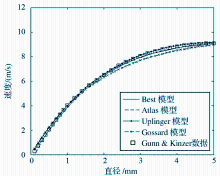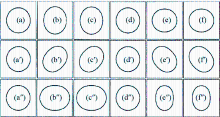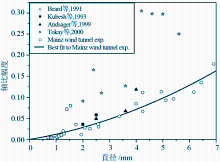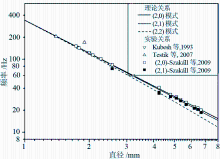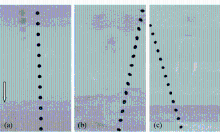刘西川(1985-),男,河北清河人,博士研究生,主要从事大气物理与大气探测技术研究. E-mail:liuxc85@gmail.com
雨滴的尺度、速度、形状、轴比、摆动和空间取向及其谱分布等微物理性质是揭示降雨物理本质的重要特征量,对于土壤侵蚀机理研究、天气雷达地面标定、人工增雨作业效果评估、无线电通讯和导航系统通道选择等方面均有着重要意义。首先分析了19世纪末以来雨滴微物理特征的测量及研究发展历程,分析了实验室内风洞实验、光学雨滴谱仪外场观测等雨滴微物理特征测量技术的现状以及存在的不足,重点讨论雨滴的形状、速度、摆动和空间取向特征等微物理特征。现有雨滴谱仪并不能完全揭示自然环境条件下雨滴的微物理特征,从而限制了雨滴微物理特征在相关领域的应用。最后从相关领域和应用发展的角度出发,对雨滴微物理特征测量技术的发展做了展望。
The size, fall velocity, shape, axis ratio, oscillation, orientation, and their spatial distributions of raindrops are the key parameters for study of rainfall physics, which also have great significance in these fields such as research on the mechanism of soil erosion, calibration of weather radar, classification of present weather, evaluation of rainfall enhancement, and determination of channel in radio communication and navigation systems. This paper reviews the history of measurement technology and method of raindrops’ microphysical features firstly, discusses the status and shortcomings of laboratory wind tunnel experiment, optical disdrometer, and other measurement techniques and theory for the raindrops’ microphysical features, and then the shape, fall velocity, oscillation, and orientation of raindrops are analyzed. Existing disdrometers cannot measure the all the micro-physical characteristics of raindrops, which limit the application of raindrops microphysical characteristics in related area. At last from the point of view of relative area and application, the prospect of the future development trend of raindrops microphysics measurement techniques is concluded.
降雨是大气水循环的主要环节,反映了地球大气的动力、热力、水汽等多种要素的相互作用[ 1]。其中,雨滴在空气中受重力作用的降落过程中,由于受到表面张力、空气动力、内部压力、湍流等多种力的相互作用,其尺度、速度、形状、轴比、摆动和空间取向及其谱分布等微物理性质呈现不同的特征[ 2]。雨滴的尺度、形状、速度及其谱分布与雷达回波的相关关系是天气雷达定量估计降水的重要基础[ 3],雨滴的尺度和速度是研究陆面过程中土壤侵蚀机理的重要依据[ 4],雨滴的形状和折射率是研究雨致电磁波散射和衰减的重要前提[ 5]。因此研究这些微物理特征及其测量技术,对于云雨物理的科学认识、人工增雨作业的效果评估、无线电通讯和导航系统中的通道选择、主动和被动遥感中的反演模型修正等方面均有着重要作用[ 6, 7]。
在大气科学和相关领域发展的需求牵引下,国外最早在19世纪末就已经开始对雨滴形状开展研究[ 8],但是受到当时技术水平的限制,测量大多以手动操作为主、采样分辨率低,仅能进行个例研究,远未达到自动化、实用化的程度[ 9~ 13]。直到20世纪70年代以后,随着光电技术的发展,才出现了可以外场实用、具备一定无人值守能力的降水微观特征测量仪器[ 14],可以测量降水强度、粒子谱分布等,光学雨滴谱仪的长期观测提供了广大地区的雨滴谱分布特征。本文在分析雨滴微物理特征测量技术及其发展历程的基础上,分别分析了雨滴的形状、轴比、速度、摆动等微物理特征,最后对雨滴微物理特征测量及其应用的发展进行了展望。
Bashforth等[ 15]最早于1883年对雨滴内部的流体静力学进行理论分析,Lenard[ 16]最早于1904年进行风洞试验,认为雨滴的内部应力和表面张力是雨滴变形的关键因素。Spilhaus[ 17]认为雨滴的形状近似为椭球形,大雨滴底部平坦是由空气阻力造成的。Imai[ 18]利用拉普拉斯方程的线性形式计算潜流中雨滴的长短轴之比,忽略了雨滴的内部流体静力学和外部粘性应力。Blanchard[ 19]和Magono[ 9]分别利用摄像机对风洞中的雨滴形状进行研究,给出了雨滴的典型形状。Savic[ 20]利用实测的压力分布,通过解线性方程得到雨滴形状的参数,认为雨滴的变形取决于气压,与内部静压力无关。McDonald[ 21]在Magono[ 9]获得的雨滴图像的基础上,计算了雨滴的表面压力,粗略估计了雨滴内中部的流体静压力,认为由重力决定的流体静压力是决定雨滴形状的重要因素,雨滴附近的气流造成了雨滴的不对称。
借助于光电技术的发展,Pruppacher等[ 12]和Beard等[ 22]在UCLA云物理实验室的风洞中利用高速摄像机对雨滴形状做进一步研究,将雨滴的长短轴之比作为雨滴形状的参数;Richard等[ 23]和Rasmussen等[ 24]的研究发现,风洞当中的雨滴变形的情况和暴风雨中的雨滴相似。Green[ 25]考虑扁球体在其赤道附近上的表面张力和内部水压平衡,估计了长短轴之比。Jameson等[ 10]通过对近地面层的雨滴进行成像研究了雨滴形状、摆动等参数,认为雨滴的摆动会影响雷达的差分反射率因子。Jameson[ 26]通过实验发现摆动雨滴的平均轴比与PP模型有较大差别。Chandrasekar等[ 11]利用空基的二维粒子测量系统对地表1 km以上高度的雨滴进行测量,研究雨滴的轴比和摆动对雷达差分反射率因子的影响。
Mitra等[ 27, 28]分别利用Mainz垂直风洞研究了悬浮其中的雨滴的形状、摆动和内部环流,得出了进一步的结论。Bhalwankar等[ 29]利用垂直风洞研究了电场条件下的雨滴变形情况,得出了水平电场比垂直电场更易让雨滴发生变形的结论。Szakall等[ 30]利用Mainz垂直风洞,引入新方法研究了雨滴的形状、摆动和内部环流等参数,得出了更为准确的结果;Jones等[ 31]利用垂直风洞研究得到了悬浮水滴的形状、摆动等参数,在平均轴比等参数上得出了与前人不同的结论。
在测量雨滴大小和谱分布方面,最早的方法是吸水纸法、面粉法和浸润法等人工操作方法[ 32],由于此类方法需要较多的人工操作,存在测量精度低、工作量大、测量实时性差、成本高以及无法自动分类等缺点,一般用于雨滴谱仪的比对,目前已逐步被淘汰。随着材料技术、光电技术和数字信号技术的发展,分别出现了以Joss-Waldvogel雨滴谱仪[ 33]为代表的振动式雨滴谱仪,以OTT PARSIVEL雨滴谱仪[ 34]为代表的光学雨滴谱仪,以2D Video Disdrometer(2DVD)[ 35]为代表的高速线阵扫描雨滴谱仪,和以ITC-4123 hydrophone[ 36]为代表的声学雨滴谱仪。这些雨滴谱仪已经在文献[ 4, 37]中详细阐述,本文不再展开。这些雨滴谱仪的缺点是只能测量雨滴的尺度谱分布,但是大多对雨滴形状存在一定的假设,无法测量雨滴和其他类型降水粒子的真实形状[ 38],而且存在较大的速度测量误差[ 6]。
2DVD是目前能够测量降水微物理特征最多的仪器,可以测量粒子的体积、等体积直径、轴比、速度、谱分布等参数,但是粒子穿过上下2个光束的不匹配,会导致速度计算误差;当有水平风存在时,粒子穿过测量区域会发生水平位移,从而导致粒子图像的变形;且2DVD围栏的形状也会导致有风条件下小粒子的数量误差[ 15]。Schuur[ 39]、Brandes[ 40]、Huang[ 41]、Schonhuber[ 42]、Thurai[ 43]等多个学者分别利用该设备对人工模拟降雨和自然降雨进行观测,并与垂直风洞试验、多普勒天气雷达等多种设备分别对进行同步对比观测,得到了很多一致性结论,但是2DVD的价格昂贵,目前在我国大陆地区尚没有应用的实例。
在雨滴速度的测量方面,Lenard和Schimit分别在实验室内测量了大雨滴的降落速度[ 44];Laws等[ 45]利用频闪分析仪研究了静止空气中降水粒子的速度;Davies[ 46]研究了低密度条件下的降水粒子降落速度;Gunn等[ 47]利用电势脉冲法测量了标准大气条件下(气压1 013 hPa,温度20℃,相对湿度50%RH)的雨滴降落速度;Beard等[ 48]在实验室内研究了海平面大气条件下小水滴的降落速度。Barthazy等[ 49]和Thurai等[ 43]分别利用Hydrometeor Velocity Shape Detector和2DVD对野外自然条件下的雨滴速度进行了测量。国内相关研究起步较晚,刘大为等[ 50]和刘俊杰等[ 51]分别对雨滴运动和收尾速度进行了理论分析,苏小勇等[ 44]对不同大气条件下的雨滴降落末速度进行了理论分析。梁伟等[ 52]利用摄影法研究了人工降雨装置中的水滴速度,但是目前尚没有仪器能够对自然条件下的雨滴速度进行测量。
Pruppacher等[ 12]通过考虑下落雨滴表面上任意一点的内外压力平衡来计算雨滴的形状,把雨滴描述为椭球形状,利用轴比作为雨滴形状的参数,即PP模型:
 | (1) |
其中, 



Ross等[ 55]为了便于雨滴光学散射特性的分析,在PP模型和BC模型的基础上提出了近似椭球模型,考虑到雨滴的截面对称性,近似椭球模型将等体积近似问题简化为截面近似,将BC模型近似成椭球体,详细参数如表1所示[ 54]。
Thurai等[ 56]利用2DVD的实测结果对雨滴形状进行拟合,得出了直角坐标系中的形状方程:
 | (2) |
其中, 



图1分别给出了PP模型、BC模型、近似椭球模型、Thurai模型与2DVD实测形状[ 57]。由图1可知,(1)当雨滴较小( Deq< 2mm)时,雨滴基本保持球形,随着雨滴的增大( Deq > 2mm),雨滴呈现顶部圆滑、底部平坦的形状,雨滴越大越扁;(2)PP模型、BC模型、近似椭球模型与Thurai模型相比,PP模型的雨滴底部呈凹入状态,分析其原因是该模型对底部气流估计过大;BC模型的雨滴底部则保持平坦形状;近似椭球模型介于前两者之间;Thurai模型与BC模型基本一致;(3)理论模型与实际观测结果相比,BC模型和Thurai更为符合雨滴的实际形状;而近似椭球模型与BC模型差异较小,基于此计算的雨滴散射特性可以更为准确获取电磁波在降雨中的传播特性,有助于天气雷达探测精度的提高。
在雨滴的形状模型中,往往将轴比(竖直轴与水平轴之比 b/a)作为雨滴形状的主要参数。Pruppacher和Beard在风洞实验的基础上提出了PB模型[ 58],认为轴比(b/a)与等体积直径( Deq)成线性关系:
 | (3) |
Pruppacher等[ 12]提出的PP模型认为雨滴轴比( b/a)与其等体积直径基本为线性关系:
 | (4) |
Beard等[ 22]提出的BC模型认为轴比( b/a)与等体积直径的关系式满足下列四阶多项式:
 | (5) |
Beard等[ 59]在实验室测量结果的基础上提出了小雨滴段的轴比与等体积直径的关系(以下简称BK模型):
 | (6) |
Goddard等[ 60]利用实验室测量和雷达测量结果对轴比和等体积直径进行拟合,得到下列二项关系式(以下简称Goddard模型):
 | (7) |
Andsager等[ 61]利用双偏振雷达和雨滴测量装置的对比分析,得到轴比与等体积直径的关系式(以下简称Andsager模型):
 | (8) |
| 表1 雨滴近似椭球模型的详细参数 Table1 The parameters of approximate ellipsoid model of raindrops |
Keenan等[ 63]利用多个经验关系和雷达实测结果,推导出轴比与等体积直径的关系式(以下简称Keenan模型):
 | (9) |
Brandes等[ 64]综合多个观测结果,提出下列经验方程(以下简称Brandes模型):
 | (10) |
Thurai等[ 43]利用设置与地面处的2DVD设备对从80m高度模拟的人工降雨进行测量,得出轴比的拟合方程(以下简称TB模型):
 | (11) |
后对其进行改进[ 56],得到下列方程(以下简称TB改进模型):
 | (12) |
图2分别列出了PB模型、PP模型、BC模型、BK模型、Goddard模型、Andsager模型、Keenan模型、Brandes模型和TB改进模型与2DVD实测数据[ 43]。由图可知,(1)当雨滴等体积直径D<1mm时,雨滴基本保持球形,轴比近似等于1,而当D ≥ 1 mm时,轴比随等体积直径的增大呈近似线性减小的趋势。(2)PB模型和PP模型的线性关系在整体上能反映实际雨滴的轴比变化趋势,但是平均误差相对较大;BK模型、Goddard模型和Andsager模型在其适用区间内与实际雨滴的轴比变化情况有较好的一致性;BC模型和Brandes模型在全区间内与实测数据有较好的一致性,在大滴段偏差略有增大;Keenan模型在D< 7 mm时与实测数据比较符合,D > 7 mm时出现显著偏差。(3)在全区间范围内,与PB模型和PP模型的线性关系相比,BC模型和TB改进模型更适用于描述雨滴的轴比变化。
雨滴在大气中受到重力、空气阻力和浮力的综合作用,其降落过程是一个变加速过程,随着时间加速度逐渐减小,在达到一定时间、一定距离后达到平衡状态,此后做匀速运动,此时雨滴的速度即为降落末速度[ 44]。
Best[ 65]根据Davies[ 46]的实测数据,提出了雨滴速度与等体积直径( Deq)的关系(简称Best模型):
 | (13) |
由于不同高度大气的密度不同,雨滴末速度也是不同的,由此提出了雨滴速度随高度的变化关系:
 | (14) |
其中, a为与大气环境条件相关的常量,在标准大气条件下 a=0.0405,在标准夏季热带大气条件下 a=0.0354, h为海拔高度。
Foote等[ 66]在Best工作的基础上,提出应当综合考虑大气压力和气温的因素:
 | (15) |
其中, 




Atlas等[ 67]在多普勒天气雷达实测数据的基础上,提出了经验关系(简称Atlas模型):
 | (16) |
Uplinger[ 68]采用与上述类似的分析方法,提出了经验关系(简称Uplinger模型):
 | (17) |
Gossard等[ 69]在晴空多普勒天气雷达实测数据的基础上,改进了Atlas模型,提出经验关系(简称Gossard模型):
 | (18) |
与Best模型相同,Atlas模型、Uplinger模型和Gossard模型均适用于标准大气条件。下图分别列出了Best模型、Atlas模型、Uplinger模型和Gossard模型及其Gunn & Kinzer实测数据[ 47]的对比情况。由图3可知,雨滴速度随等体积直径的增大呈指数增大的趋势,模型与实测数据存在较好的一致性。
Beard[ 70]首先提出,在自然降雨中雨滴形状会偏离稳定的近似椭球形状,雨滴的碰撞会导致雨滴摆动,而这一摆动是存在一定规律的。Thurai等[ 62]在进行风洞试验时发现,当直径大于1 mm时雨滴发生摆动,而且雨滴越大,雨滴的摆动幅度就越大,从而引起雨滴的轴比变化范围扩大。Beard等[ 57]分析认为,涡流效应、碰并效应、风切变和湍流是引起摆动的原因,而当这些因素不能抵消粘性耗散效应时,下列3个因素也能够引发摆动:(1)曳力随轴比增大而增大;(2)横向的涡流分离(eddy shedding)引起的压力扰动;(3)涡流分离频率和摆动频率之间的谐振。
雨滴的摆动发生在基频附近,其频率服从球形谐波扰动[ 71]:
 | (19) |
其中, n为球形谐振扰动的级数, σ和 ρ为表面张力和水滴密度,对于每级谐波 n ( n>=2),都有 m=n+1个空间取向。由于高次谐波的阻尼效应,雨滴的摆动主要取决于基本谐振( n=2)。雨滴的详细摆动情况如下图所示,其中,第一行为轴对称摆动模式( n=2, m=0),第二行为横向摆动模式( n=2, m=1),第三行为水平摆动模式( n=2, m=2)。如下图所示,从 a到 f为按照时间序列均匀排列的一个摆动周期。
理论研究发现,小滴以对称的方式摆动,而非球形大雨滴受到重力效应的影响,呈现轴对称、横向和水平3种摆动方式。而Andsager等[ 72]通过对小雨滴的实验发现:对于直径小于1 mm的雨滴,其形状与BC模型一致,轴比的变化在实验误差以内;对于直径介于1~1.3 mm之间的雨滴,其摆动为出现在基频上的横向摆动;对于直径介于1.4~1.54 mm之间的雨滴,其摆动为轴对称摆动;更大的雨滴也以轴对称摆动为主。
下图为雨滴的摆动幅度随直径的变化情况,其中点为实测数据,实线为拟合曲线。由图可知,雨滴越大,摆动幅度越大,振幅为其直径的2%左右。
图6为根据公式(19)所绘出的3种模式摆动的频率与Kubesh[ 74]、Tetik[ 75]、Szakall[ 30]等的实测结果进行比较的结果。由图6可知,小雨滴实测频率与理论频率有较好的一致性,而大雨滴实测频率与其理论频率的一致性稍差,但也在测量误差的范围内。
Testik[ 71]在利用高速成像仪对雨滴的摆动进行的研究发现,摆动雨滴在下降过程中,还会出现横向漂移,且该漂移方向是没有选择性的,即出现在任意方向都是随机的。由于该实验在稳定环境中进行,因此可以排除大尺度的湍流效应,其原因主要是雨滴顶部侧面的涡流效应,这也是雨滴横向摆动模式的主要驱动机制。如下图为高速摄像机采集的雨滴图像,(a)为无摆动雨滴的降落路径,(b)和(c)为有摆动雨滴的降落路径。实验发现雨滴的摆动还会引起横向漂移,其横向运动是各向随机的,其横向运动速度约为其降落末速度的20%~30%。
雨滴的取向是指雨滴的对称轴(旋转轴)与垂直方向的夹角(又称倾斜角 

McMormick等[ 77]根据圆极化波雷达的测量,发现雨滴形成了一个高度取向的介质,其对称轴平行于垂直方向。Hendry等[ 76]利用线偏振X波段雷达探测强降雨发现,雨滴的平均倾斜角 






Huang等[ 41]在稳定、低风速的自然环境中,利用2DVD对距地面80 m高度模拟的人工降雨进行观测。由于2DVD有两个垂直设置的图像传感器,可以获取雨滴的侧视和正视图像,因此可以得到雨滴在2个方向的倾斜角。观测结果发现,倾斜角的平均值 




雨滴在空气中是一自由落体过程,从云中降落到地面时呈现不同的形状、尺度、速度、动能、液态含水量、摆动、空间取向、电荷等物理特性,研究这些微物理特征对于降水物理机理研究、天气雷达地面标定等方面均有着重要的理论和实际意义。但是目前雨滴微物理特征研究尚存在一定不足,从理论方面,对雨滴的形状、尺度、速度有多种成熟模型,但是对摆动、空间取向、电荷等没有确定模型,而且实际情况复杂多变,难以准确建模;从试验方面,大多是利用垂直风洞研究雨滴的形状和速度等,基于此建立了多种模型,但是风洞与实际存在很大差异,风洞结果与实际降水特征并不完全一致;从测量技术方面,现有雨滴谱仪大多只能测量雨滴的尺度和谱分布,2DVD是目前能够测量降水粒子最多参数的仪器,但是易受风场和仪器构造的影响,无法准确测量降水粒子的形状和速度。
对于天气雷达定量估计降水,地面降水的相态、形状、尺度、速度及其谱分布是准确反演降水的基础;对于陆面过程和土壤侵蚀研究,降水粒子的尺度、速度及动能是准确评估土壤侵蚀的关键;对于电磁波在降水中的传播评估,降水粒子的相态、形状、折射率是计算降水粒子散射特性的重要参数。要满足这些领域对降水微物理特征的需求,需要从理论建模和测量技术两方面做工作,重点发展具有自主知识产权的降水微物理特征测量仪器,实现对自然条件下雨滴以及固态降水粒子的准确测量,通过获取广泛地区的降水微物理特征建立降水粒子的尺度、形状、速度、摆动、取向等模型。并将其应用到天气雷达定量估计降水、陆面过程研究、电磁波传播评估等领域,推动降水微物理资料的精细化应用,从而提高公共气象服务能力。
| [1] |
|
| [2] |
|
| [3] |
|
| [4] |
|
| [5] |
|
| [6] |
|
| [7] |
|
| [8] |
|
| [9] |
|
| [10] |
|
| [11] |
|
| [12] |
|
| [13] |
|
| [14] |
|
| [15] |
|
| [16] |
|
| [17] |
|
| [18] |
|
| [19] |
|
| [20] |
|
| [21] |
|
| [22] |
|
| [23] |
|
| [24] |
|
| [25] |
|
| [26] |
|
| [27] |
|
| [28] |
|
| [29] |
|
| [30] |
|
| [31] |
|
| [32] |
|
| [33] |
|
| [34] |
|
| [35] |
|
| [36] |
|
| [37] |
|
| [38] |
|
| [39] |
|
| [40] |
|
| [41] |
|
| [42] |
|
| [43] |
|
| [44] |
|
| [45] |
|
| [46] |
|
| [47] |
|
| [48] |
|
| [49] |
|
| [50] |
|
| [51] |
|
| [52] |
|
| [53] |
|
| [54] |
|
| [55] |
|
| [56] |
|
| [57] |
|
| [58] |
|
| [59] |
|
| [60] |
|
| [61] |
|
| [62] |
|
| [63] |
|
| [64] |
|
| [65] |
|
| [66] |
|
| [67] |
|
| [68] |
|
| [69] |
|
| [70] |
|
| [71] |
|
| [72] |
|
| [73] |
|
| [74] |
|
| [75] |
|
| [76] |
|
| [77] |
|
| [78] |
|
| [79] |
|
| [80] |
|
| [81] |
|












